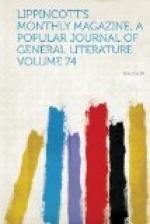ILLUSTRATIONS THE QUINTA DE LA MISERIA. HOW THE POOR TRAVEL IN PARAGUAY. VIEW OF IBITIMI. ITAPE: PALACE AND CHURCH. INTERIOR OF THE CHURCH AT VILLA RICA. A JAGUAR TRAP. UNCAPTIONED FOUNDRY AT IBICUY, DESTROYED DURING THE WAR. VILLAGE OF CARAPEGUA.
UP THE PARANA AND IN PARAGUAY.
Concluding paper.
One day—to return to our traveler and his personal experiences—M. Forgues makes the acquaintance of a Swiss who resides at Paraguari, a small interior town distant about twenty-five leagues from Asuncion. His new acquaintance invites him to go with him to Paraguari, but before complying with the invitation M. Forgues crosses the river and rides into the territory of Gran Chaco as far as the Quinta de la Miseria, situated about two miles and a half from the river-bank. The owner of this farm, Mequelain, a French pioneer, his wife and three servants, had been surprised and murdered by the Chaco Indians a short while before the arrival of M. Forgues in Asuncion. The quinta is on the edge of a vast plain. The unfortunate Mequelain had surrounded his house with ditches and a small fence of posts. Besides this, he had built a sort of observatory from which to watch the movements of the Indians. But his precautions, as the end showed, proved useless. The farm was occupied by new tenants at the time of M. Forgues’s visit, and the bodies of the five victims were buried in one of the ditches. The Quinta de la Miseria derives its gloomy name from the tragic event that had given it its melancholy prominence in the minds of the people of Asuncion. To reach Paraguari our traveler avails himself of the railroad which extends between that town and the capital. The railroad-station presents a lively scene with its crowd of savage-looking natives thronging it. In connection with this station M. Forgues mentions a curious circumstance—that in order to prevent the rush of the multitude to the cars on the departure of the train the station-master has ingeniously replaced gates and fences, which might be climbed easily, with brushes steeped in pitch and tar, so disposed as to bar the passage. As the Paraguayan women hold cleanliness to be one of the cardinal virtues, they religiously avoid these defiling brushes for fear of soiling their garments. The cars are built on the most approved American model. The train, furthermore, has two platform-cars attached to it, which are reserved exclusively for the gratuitous use of the poor, who are permitted to ride on them with as much as they can carry in the way of bundles and other goods. Sometimes the platforms are so crowded that they are lost to sight under the passengers’ heads and legs. Another feature of railway travel in Paraguay—for a foreigner a sensation—is to observe a woman clad in the Arcadian simplicity of a single garment enter a car and take a seat opposite you or alongside of you with the most unconstrained air imaginable.




